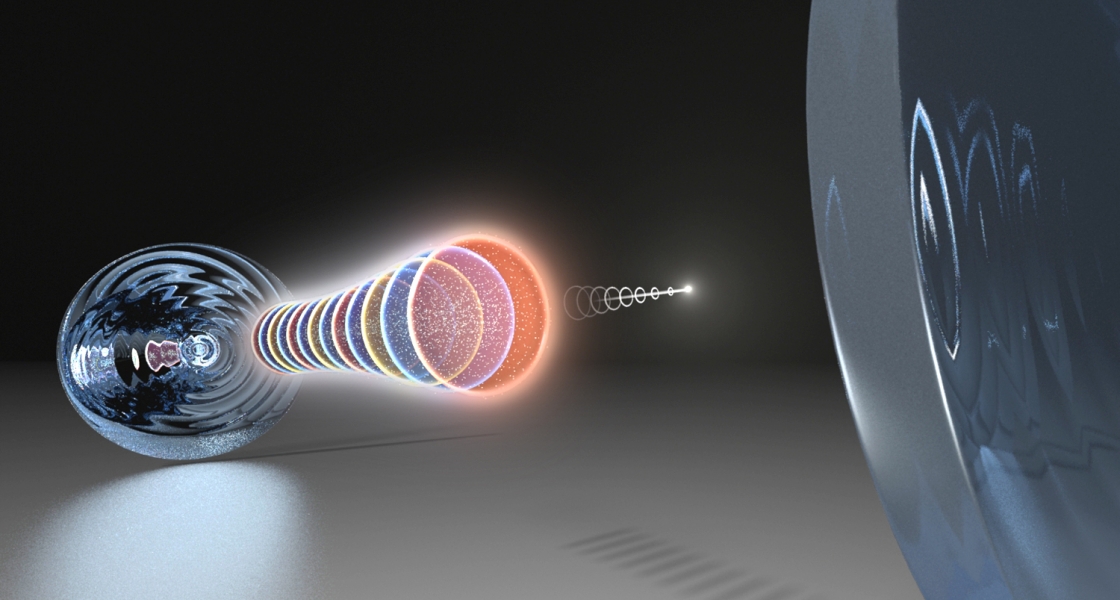The Thompson group, with theory help from the Holland group, recently demonstrated a superradiant laser that escapes the “echo chamber” problem that limits the best lasers. To understand this problem, imagine an opera singer practicing in an echo chamber. The singer hears his own voice echo from the walls of the room. He constantly adjusts his pitch to match that of his echo from some time before. But, if the walls of the room vibrate, then the singer’s echo will be shifted in pitch after bouncing off of the walls. As a result, if the singer initially started singing an A, he may eventually end up singing a B flat, or a G sharp, or any other random note — spoiling a perfectly good night at the opera.
In a laser, there is an entire choir composed of atoms that don’t sing, but instead emit light. The atoms in the laser also “hear” and adjust their pitch to match their own echo that comes from the emitted light reflected back to them by the laser mirrors surrounding the atoms. Even if the laser is placed in the quietest room imaginable, the mirrors will still vibrate because atoms simply can’t hold completely still. As a result, a normal laser’s pitch, or frequency, will wander around — spoiling a perfectly good night at the lab.
The new superradiant laser avoids the echo chamber distortions because emitted light quickly leaks out of its mirrors much faster than the choir of atoms loses track of the note it is singing. But, there is more involved in building a laser with nearly perfect pitch. For instance, it’s critical to avoid bad singers. To accomplish this, the Thompson group hired a pretty talented choir composed of a million laser-cooled and trapped Rubidium atoms.
Because of its talented choir and its much smaller echo, the new laser’s pitch is ten thousand times less likely to be altered by rippling mirrors than is the pitch in a normal laser. As a result, its pitch is a hundred times sharper than the best normal lasers. The new laser was built by Fellow James Thompson and graduate students Justin Bohnet, Zilong Chen, and Josh Weiner. Former postdoctoral researcher Dominic Meiser of the Holland group provided theory support.
Naturally, there are tradeoffs for getting perfect pitch. The leaky mirrors mean that the laser operates in a strange regime where an average of less than one photon of light bounces between the mirrors. This small amount of light acts like a very weak telephone line between the atoms, allowing them to agree to sing the same note.
The atoms are trapped in stacks of 5000 by a one-dimensional crystal of light. Not only do the atoms in each crystal sing the same note, but they also sing in just the right way. Consequently, the rate at which the light is emitted increases as the square of the number of atoms, making the laser much brighter.
A similar effect can occur when crickets start chirping. At first, the crickets seem to chirp at random. But, if the chirping keeps on, pretty soon the crickets get synchronized. In the laser, not only do the atoms chirp at the same time, but they also chirp in the same direction (a feature that is very handy in a laser). When all the crickets get synchronized, the loudness of the chirping increases as the square of the number of crickets — just like the light emitted by atoms in a superradiant laser.
In the laser, entire chains of atoms inside each light crystal go back and forth in unison between being in an excited state and a calm (ground) state. And, because at least one photon is communicating between the crystals, all the stacks of atoms soon oscillate in unison. As soon as all the atoms inside the laser are moving in sync, they form a “super spring.” The super spring loses energy by emitting much “louder” laser light than would be possible if the atoms sang alone. Listen to physicist James Thompson describe how this innovative laser works.
The new superradiant laser may lead to better atomic clocks, more precise distance measurements, and searches for new fundamental physics. For instance, with different atoms, it could be an optical atomic clock itself! In the future, superradiant lasers may be used to create rulers spanning the distance from the Earth to the Sun or to improve Fellow Jun Ye’s strontium optical lattice clock by leaps and bounds. The invention of the new superradiant laser is a classic example of the great benefits of JILA’s culture of collaboration.
A Letter describing this research was published by Nature online on April 4, 2012. The new laser was also featured in the same issue's New and Views section.— Julie Phillips and James Thompson




